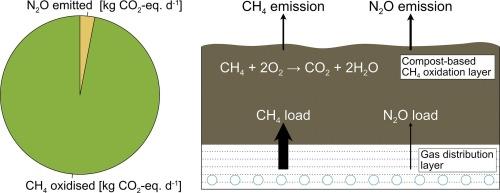Do compost-based landfill biocover systems designed for methane oxidation emit nitrous oxide in significant amounts?
IF 7.1
2区 环境科学与生态学
Q1 ENGINEERING, ENVIRONMENTAL
引用次数: 0
Abstract
Landfills constitute a significant source of methane (CH4), thereby contributing to climate change. CH4 emissions from old and smaller landfills can be mitigated by compost-based biocover systems designed for optimal microbial CH4 oxidation. It is well-known that the strong greenhouse gas nitrous oxide (N2O) is generated during the composting process, which potentially could continue after incorporating compost into the biocover system. Field studies were performed at three full-scale biocover systems established at Danish landfills and included surface screenings, surface flux measurements and gas composition analysis. To assess if N2O generated in the biofilter-compost material would hamper the climate benefit from CH4 oxidised in a biofilter, CH4 removed was compared to N2O generated, with both calculated in CO2-eq. Two assessments were performed. The first considered individual measurement locations on the biocover, whereas the second considered the overall performance of the biocover. By comparing CH4 oxidation rates to the emitted N2O, both approaches showed that there is no risk that N2O emission will negatively affect the CH4 mitigation efficiency of compost-based biocover systems established at landfills. The ratio of N2O emitted to CH4 oxidized (both in unit kg CO2-eq per day) was less than 2.3% for both approaches, and in most cases below 1%.

为甲烷氧化而设计的堆肥型垃圾填埋场生物覆盖系统是否会大量排放一氧化二氮?
垃圾填埋场是甲烷(CH4)的重要来源,从而导致气候变化。旧的和较小的垃圾填埋场排放的甲烷(CH4)可以通过堆肥生物覆盖系统来缓解,该系统的设计目的是优化微生物对甲烷(CH4)的氧化作用。众所周知,堆肥过程中会产生强烈的温室气体一氧化二氮(N2O),将堆肥加入生物覆盖物系统后,一氧化二氮可能会继续产生。在丹麦垃圾填埋场建立的三个全规模生物覆盖系统进行了实地研究,包括表面筛选、表面通量测量和气体成分分析。为了评估生物滤池堆肥材料中产生的一氧化二氮(N2O)是否会影响生物滤池中氧化的甲烷(CH4)所带来的气候效益,将甲烷(CH4)去除量与产生的一氧化二氮(N2O)进行了比较,两者均以二氧化碳当量(CO2-eq)计算。进行了两项评估。第一项评估考虑了生物覆盖物上的单个测量位置,第二项评估则考虑了生物覆盖物的整体性能。通过比较 CH4 氧化率和 N2O 排放量,两种方法都表明,N2O 排放不会对垃圾填埋场堆肥生物覆盖物系统的 CH4 减排效率产生负面影响。两种方法的 N2O 排放量与 CH4 氧化量之比(单位均为千克二氧化碳当量/天)均低于 2.3%,大多数情况下低于 1%。
本文章由计算机程序翻译,如有差异,请以英文原文为准。
求助全文
约1分钟内获得全文
求助全文
来源期刊

Waste management
环境科学-工程:环境
CiteScore
15.60
自引率
6.20%
发文量
492
审稿时长
39 days
期刊介绍:
Waste Management is devoted to the presentation and discussion of information on solid wastes,it covers the entire lifecycle of solid. wastes.
Scope:
Addresses solid wastes in both industrialized and economically developing countries
Covers various types of solid wastes, including:
Municipal (e.g., residential, institutional, commercial, light industrial)
Agricultural
Special (e.g., C and D, healthcare, household hazardous wastes, sewage sludge)
 求助内容:
求助内容: 应助结果提醒方式:
应助结果提醒方式:


